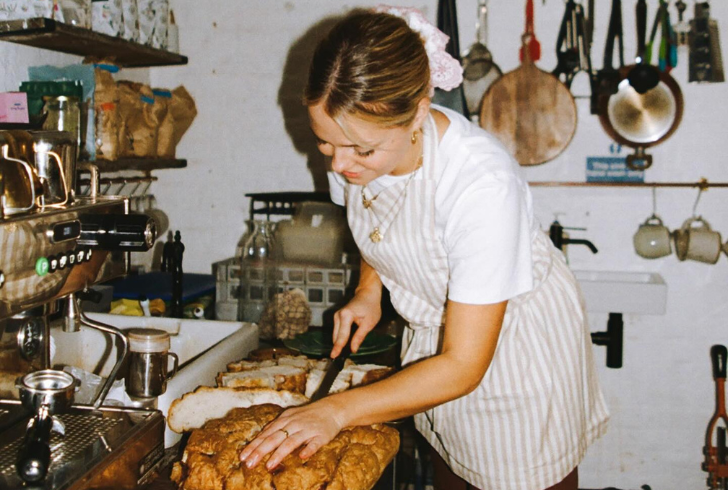The Hidden Truth About ‘Chalet Girls’ Who Cater to Skiers’ Every Need
Long before the first ski lift hums to life on a winter morning, the staff inside Europe’s most luxurious chalets are already working. Among them are the often-glamourized yet misunderstood “chalet girls.”
For decades, they’ve been associated with a certain image—young, posh, and carefree. But the truth behind the snow-covered rooftops and roaring fireplaces tells a very different story.
Who Are the Chalet Girls Today?
Once viewed as a rite of passage for upper-class British girls fresh out of boarding school, chalet roles have significantly evolved. While the term “chalet girl” still lingers, it’s increasingly outdated. The job is no longer a playground for the wealthy elite. Applicants now come from diverse backgrounds, and many companies report an even gender split among their teams.

Instagram | indiahogg | The glamorous celebrity presence in Courchevel 1850 felt dreamlike to India Hogg amidst her routine work.
The original stereotype, popularized in the movie “Chalet Girl”, showed a lighthearted version of chalet life—glamour, flirtation, and endless fun. But according to those who’ve actually done the job, the reality is far from that silver-screen portrayal.
India Hogg, who worked in Courchevel 1850, recalls, “Everything felt surreal. You’re preparing breakfast, and across the street, Gordon Ramsay’s chalet is facing David Beckham’s.” While the celebrity proximity might sound luxurious, the day-to-day tasks were anything but.
What the Job Really Entails
Working as a chalet girl (or boy) means handling everything from cooking and cleaning to organizing ski gear, serving drinks, and even offering concierge-level service. And unlike the guests they cater to, these staff members don’t get to lounge in jacuzzis or sip champagne by the fire. A typical day starts before 7 a.m. and can easily stretch past midnight.
One former chef, Sophie Crowther, described her first morning on the job in Les Gets: “I’d slept under a bar, barely caught an hour of sleep, and then had to cook breakfast for 25 people while feeling incredibly sick. It was rough.”
Many live in cramped accommodations, sometimes above loud bars or far from the chalets where they work. Long treks in the snow, lack of sleep, and minimal privacy are all part of the experience. But despite the physical exhaustion, many say the job creates a strong bond among staff.
A Competitive Industry With a Shrinking Workforce
Working in a luxury chalet has become more competitive than ever. Some companies receive over 2,000 applications for just a few hundred seasonal roles. According to Ceri Tinley of Consensio Chalets, only about one in fifteen applicants secure a position. The intense demand has raised the bar, with employers looking for staff who can offer five-star service with a smile—no matter how tired they are.
Andy Sturt from VIP Ski emphasizes that, “It’s all about personality. You need someone who can clean bathrooms in the morning and then host a high-end dinner party at night without missing a beat.”
Brexit has also played a role in reshaping the industry. Hiring UK nationals now often requires work permits and visas, leading many companies to prefer staff with EU citizenship or residency status. As a result, the British presence in the chalets has decreased dramatically over the past decade.
The Not-So-Glamorous Side of Luxury

Instagram | sophiesmunch | Facing a large breakfast order while ill and sleep-starved made for a very difficult first morning for Sophie Crowther.
Though the chalets may feature private cinemas, raclette rooms, and wine cellars, those amenities are strictly for guests. Staff caught using the facilities can quickly find themselves without a job or a place to stay.
Pay ranges widely but is rarely high. Some report earning around $1,300 a month, often less than the UK’s minimum wage once hours are factored in. However, perks like ski passes, accommodation, meals, and generous tips help balance the equation. Still, the job isn’t about money—it’s about the lifestyle and the slopes.
Hogg sums it up honestly: “There were mornings I just couldn’t face the mess left behind by guests. But then you remember where you are—on top of a mountain, part of something unique.”
Crowther also reflects on the mental toll: “You’re always on. Looking after guests nonstop. It gets intense. But every now and then, you let off steam because you have to.”
The Label Is Fading, But the Work Remains
Though the image of the posh, party-loving chalet girl still lingers in pop culture, the real job today is rooted in professionalism, discipline, and long hours. The title may sound lighthearted, but those behind it are often juggling a serious workload in one of the most demanding hospitality environments in Europe.
Chalet girls aren’t just cooking and cleaning—they’re managing guest expectations at the highest level. The role may still come with mountain views and the occasional chance to ski, but it’s far from a vacation. It’s work—often grueling, always challenging, and occasionally rewarding in the most unexpected ways.